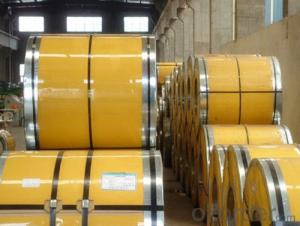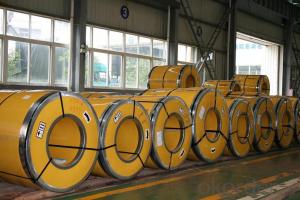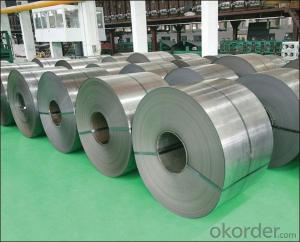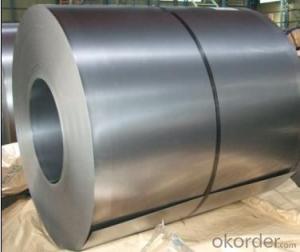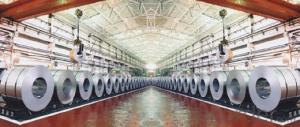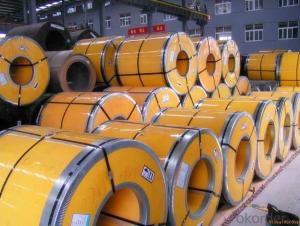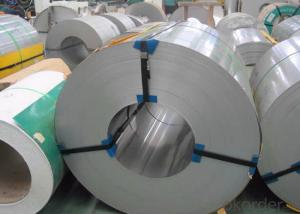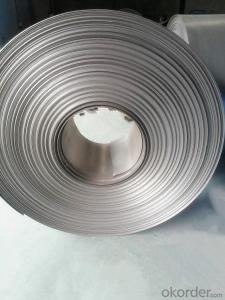Cold Rolled Stainless Steel Strip 304 Serious
- Loading Port:
- Shanghai
- Payment Terms:
- TT OR LC
- Min Order Qty:
- 25 m.t.
- Supply Capability:
- 100000 m.t./month
OKorder Service Pledge
OKorder Financial Service
You Might Also Like
Cold Rolled Stainless Steel Strip 304 Serious
1.Structure of Cold Rolled Stainless Steel Strip 304 Serious
Cold Rolled Stainless Steel Strip 304 Serious is one of the raw material of the cold rolled stainless steel strip, which can be used directly in many places. Stainless Steel (Stainless Steel) is short for acid-proof Stainless Steel, resistant to weak corrosive medium such as air, steam, water, or with a Stainless Steel grade.
2.Main Features of Cold Rolled Stainless Steel Strip 304 Serious
1) weldability: The purpose of the different requirement for welding performance are different.1 Kind of tableware generally do not require the performance of welding, even including some pot class enterprise. But the vast majority of products all need raw materials welding performance is good, like the 2 kinds of tableware, thermos flask, steel pipes, water heaters, water dispensers, etc.
2) Corrosion resistance The vast majority of stainless steel products for corrosion resistant performance is good, like a, 2 kinds of tableware, kitchen utensils and appliances, water heaters, water dispensers, etc., some foreign businessmen on corrosion resistance of products also do experiment: in NACL aqueous solution heated to boiling, after a period of time the best solution, wash and drying, weight loss, to determine the degree of corrosion (note: the product polishing, because of the sand cloth or sandpaper containing Fe, will cause the test surface rust spots)
3) Polishing performance In today's society stainless steel products in production after polishing the process commonly, when only a small number of products such as water heaters, water dispenser tank don't need polishing. So this will require materials polishing performance is very good. The factors influencing polishing performance mainly include the following: 1) raw material surface defects. Such as scratch, pitting, pickling, etc. (2) raw material problem. Hardness is too low, easy when polishing cast light (BQ), and the hardness is too low, the surface easily when deep drawing appear orange peel phenomenon, which affects the BQ. Relatively high hardness of BQ sex is good. (3) after deep drawing products, great deformation area surface will be a small black spots and RIDGING, thus affecting the BQ.
4) Heat resistant performance Heat resistant performance refers to the high temperature stainless steel can still maintain its excellent physical and mechanical properties. Carbon: the influence of carbon in austenitic stainless steel is formed strong and steady. Set the austenitic austenitic area and expand elements. Carbon formation of austenite is about 30 times that of the nickel, the ability of carbon is a kind of gap elements, through the solid solution strengthening can significantly increase the strength of the austenitic stainless steel. Carbon austenitic stainless steel can be improved in high concentration chloride (e.g., 42% MgCl2 boiling solution) in the performance of the resistance to stress corrosion. But, in the austenitic stainless steel, carbon is often seen as the harmful elements, this is mainly due to the corrosion of stainless steel used in some conditions, such as welding or heating by 450 ~ 850 ℃), carbon steel with chromium in forming high chromium Cr23C6 type carbon compounds which can lead to local chromium depletion, make steel corrosion resistance especially resistant to intergranular corrosion performance degradation. So. Since the 60 s of the development of new cr-ni austenitic stainless steel is mostly carbon content less than 0.03% or 0.02% of the ultra-low carbon type
5) Corrosion resistance When the atomic number of no less than 12.5% chromium content in steel, can make the steel electrode potential mutations, the negative potential to the positive electrode potential. To prevent electrochemical corrosion.
3. Cold Rolled Stainless Steel Strip 304 Serious Images
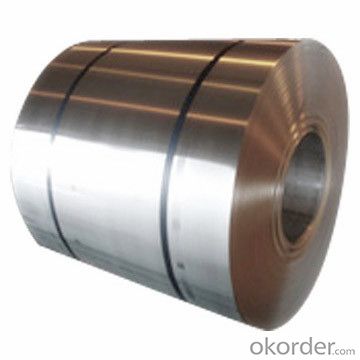
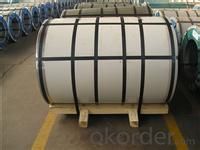
4. Cold Rolled Stainless Steel Strip 304 Serious Specification
The word "stainless steel" is not merely refers to a pure stainless steel, but said more than one hundred kinds of stainless steel industry, the development of each stainless steel has good performance in their specific applications. The key to the success of the first is to make clear purpose, and then determine the correct material. Related to architectural construction applications usually only six types of steel. They contain 17 ~ 22% chromium, good steel contains nickel. Add molybdenum can further improve the atmospheric corrosion resistance, especially containing chloride atmospheric corrosion resistance. Stainless steel often according to the state of organization can be divided into: martensite steel, ferritic steel, austenitic steel, austenitic (two-phase) - ferrite stainless steel and precipitation hardening stainless steel, etc. In addition, according to ingredients can be divided into: chromium stainless steel, chromium nickel stainless steel and chromium manganese nitrogen stainless steel, etc.
1) Ferritic stainless steel Chromium containing 15% ~ 30%. Its corrosion resistance, toughness and weldability with chromium content increases with the increase of chloride stress corrosion resistance is superior to other types of stainless steel, fall into this category of Crl7, Cr17Mo2Ti, Cr25, Cr25Mo3Ti, Cr28, etc. Ferritic stainless steel because of the high chromium content, corrosion resistance and oxidation resistance are relatively good, but the mechanical properties and process performance is poorer, more used to stress less acid structure and steel used as antioxidant. This kind of steel to withstand atmosphere, nitric acid and corrosion of the brine solution, and has good high temperature oxidation resistance, low thermal expansion coefficient, etc, used in nitric acid and food factory equipment, also can make work under high temperature parts, such as gas turbine parts, etc.
2) Austenitic stainless steel The title Chromium is more than 18%, still contain about 8% of the nickel and small amounts of molybdenum, titanium, nitrogen and other elements. Good comprehensive performance, corrosion resistant to a variety of media. Number of austenitic stainless steel is commonly used one cr18ni9, 0 cr19ni9, etc. In the Wc < 0.08% 0 cr19ni9 steel, steel grade is marked as "0". This class contains large amounts of Ni and Cr in steel, make steel in austenitic state at room temperature. This kind of steel has good plasticity and toughness, weldability and corrosion resistance and non-magnetic or weak magnetic, the corrosion resistance in oxidizing and reducing medium are good, used to make acid equipment, such as corrosion resistant containers and equipment lining, pipelines, nitric acid resistant equipment parts, etc., also can be used as the main body of watches and clocks jewelry stainless steel material. Austenitic stainless steel with solid solution treatment, the steel heating to 1050 ~ 1150 ℃, then water-cooled or air-cooled, for single-phase austenitic organization.
3) Austenitic, ferritic duplex stainless steel The advantages of both austenitic and ferritic stainless steel, and has the superplasticity. Austenite and ferrite The title Each accounts for about half of the stainless steel. In the case of contain low C, Cr content was 18% ~ 18%, Ni content at 3% ~ 3%. Some steel containing Mo, Cu, Si, Nb, Ti, N and other alloying elements. This kind of steel both austenite and ferrite stainless steel, the characteristics of compared with ferrite, plasticity and toughness is higher, no room temperature brittleness, intergranular corrosion resistance and welding performance were significantly increased, while maintaining a ferritic stainless steel of 475 ℃ brittleness and high thermal conductivity, has the characteristics of superplasticity. Compared with austenitic stainless steel, high strength and resistance to intergranular corrosion and resistance to chloride stress corrosion is improved obviously. Duplex stainless steel has excellent resistance to pitting corrosion performance, is also a kind of nickel and stainless steel.
4) Precipitation hardening stainless steel For austenitic or martensite structure matrix, and the number of precipitation hardening stainless steel commonly used such as 04 cr13ni8mo2al. It can pass the precipitation hardening (also known as the age hardening) dealing with the hard (strong) of stainless steel.
5) Precipitation hardening stainless steel For austenitic or martensite structure matrix, and the number of precipitation hardening stainless steel commonly used such as 04 cr13ni8mo2al. It can pass the precipitation hardening (also known as the age hardening) dealing with the hard (strong) of stainless steel.
5.FAQ of Cold Rolled Stainless Steel Strip 304 Serious
We have organized several common questions for our clients,may help you sincerely:
①How about your company?
A world class manufacturer & supplier of castings forging in carbon steel and alloy steel,is one of the large-scale professional investment casting production bases in China,consisting of both casting foundry forging and machining factory. Annually more than 8000 tons Precision casting and forging parts are exported to markets in Europe,
②How to guarantee the quality of the products?
We have established the international advanced quality management system,every link from raw material to final product we have strict quality test;We resolutely put an end to unqualified products flowing into the market. At the same time, we will provide necessary follow-up service assurance.
③How is the chemical compositon?
304 chemical composition:
C ≤ 0.08, Si ≤ 0.075, Mn ≤ 2.00, P ≤ 0.04, S ≤ 0.03, Ni :8.0-11.0, Cr :18.0-20.0
- Q: Can stainless steel strips be painted?
- Yes, stainless steel strips can be painted. However, it is important to properly prepare the surface by cleaning it thoroughly and applying a suitable primer before painting to ensure good adhesion and long-lasting results.
- Q: Are stainless steel strips suitable for automotive exhaust systems?
- Yes, stainless steel strips are suitable for automotive exhaust systems. Stainless steel is highly resistant to corrosion, heat, and extreme temperatures, making it an ideal material for exhaust systems that are exposed to these harsh conditions. It also provides excellent durability and longevity, ensuring the exhaust system can withstand the demands of automotive use.
- Q: Are stainless steel strips resistant to abrasion?
- Yes, stainless steel strips are generally resistant to abrasion. Stainless steel is known for its durability and strength, which makes it highly resistant to wear and tear caused by friction and abrasion. The addition of chromium in stainless steel gives it a protective layer that helps prevent scratches and abrasion. However, the level of resistance may vary depending on the specific grade and finish of the stainless steel strip. Additionally, factors such as the type and intensity of the abrasive material, as well as the duration of exposure, may also affect the resistance to abrasion.
- Q: What are the recommended storage and transportation conditions for 111 stainless steel strips?
- To prevent corrosion, it is advised to store and transport 111 stainless steel strips in a clean and dry environment. It is recommended to keep them in a well-ventilated, covered area free from moisture and excessive humidity. Storing the strips horizontally is necessary to prevent warping or bending. Moreover, it is crucial to shield the strips from chemicals, acids, and other substances that cause corrosion. When transporting, it is essential to securely package the strips using suitable materials like wooden crates or cardboard boxes. They should be appropriately wrapped or padded to avoid damage from vibration or impact during transit. Using moisture-resistant packaging is also suggested to prevent moisture absorption during transportation. By following these storage and transportation guidelines, the quality and integrity of the 111 stainless steel strips will be ensured.
- Q: Are stainless steel strips suitable for high-temperature exhaust systems?
- Yes, stainless steel strips are suitable for high-temperature exhaust systems. Stainless steel is a corrosion-resistant and heat-resistant material that maintains its strength and integrity at high temperatures. It has excellent oxidation resistance, making it ideal for applications where the exhaust gases reach elevated temperatures. Stainless steel strips can withstand the extreme heat generated by exhaust systems, ensuring durability and reliability. Additionally, stainless steel's resistance to corrosion and rust allows it to withstand the harsh conditions and corrosive elements present in exhaust systems. Overall, stainless steel strips are a suitable choice for high-temperature exhaust systems due to their heat resistance, durability, and corrosion resistance properties.
- Q: Are stainless steel strips easy to form and shape?
- Stainless steel strips, indeed, possess a relative simplicity when it comes to their formability and shaping capabilities. The reputation of stainless steel lies in its remarkable ability to be molded effortlessly into diverse shapes and sizes while maintaining its structural integrity. This is primarily due to its distinct composition, which includes a significant concentration of chromium, providing unrivaled resistance to corrosion and rendering it more pliable in comparison to alternative steel types. Moreover, stainless steel strips have the advantage of being suitable for cold working, signifying that they can be manipulated at room temperature through bending, twisting, and stretching without necessitating heat treatment. These remarkable attributes have elevated the popularity of stainless steel strips across a range of industries, including automotive, construction, and manufacturing, where precise shaping and forming are indispensable requirements.
- Q: Can stainless steel strips be used in chemical storage tanks?
- Stainless steel strips have the capability to be utilized within chemical storage tanks. The properties of stainless steel are renowned for their ability to resist corrosion, rendering it suitable for the safekeeping of various chemicals. Stainless steel is capable of withstanding a wide range of corrosive substances, such as acids, bases, and solvents. Furthermore, stainless steel possesses exceptional strength and durability, enabling it to endure the harsh conditions frequently encountered in chemical storage tanks. Its inert properties also guarantee that it does not interact with the chemicals being stored, thereby preserving the integrity of the materials being held. All in all, the corrosion resistance, strength, and durability of stainless steel strips make them a popular and favored choice for chemical storage tanks.
- Q: Can 111 stainless steel strips be coated with anti-corrosion paints?
- Yes, 111 stainless steel strips can be coated with anti-corrosion paints. Stainless steel is generally resistant to corrosion, but applying an additional layer of anti-corrosion paint can provide added protection against environmental factors and extend the lifespan of the strips.
- Q: What are the typical tolerance levels for stainless steel strips?
- The tolerance levels for stainless steel strips can vary depending on the specific requirements and applications. However, there are some typical tolerance levels that are commonly used in the industry. In terms of thickness, the tolerance levels for stainless steel strips are generally specified in terms of a plus or minus tolerance. For example, a typical tolerance for a stainless steel strip with a thickness of 0.025 inches might be +/- 0.001 inches. This means that the actual thickness of the strip can range from 0.024 inches to 0.026 inches. Similarly, the width tolerance for stainless steel strips is also typically specified as a plus or minus tolerance. For instance, a common tolerance for a strip with a width of 1 inch might be +/- 0.005 inches. This means that the actual width of the strip can range from 0.995 inches to 1.005 inches. The length tolerance for stainless steel strips can also vary depending on the specific application. However, it is common for length tolerances to be specified in terms of a maximum deviation rather than a plus or minus tolerance. For example, a typical length tolerance for a stainless steel strip might be +/- 0.010 inches. It is important to note that these tolerance levels are just examples and can vary depending on the specific requirements of the application. It is always recommended to consult the manufacturer or supplier of the stainless steel strips to determine the appropriate tolerance levels for a particular application.
- Q: What are the factors affecting the corrosion resistance of 111 stainless steel strips?
- The factors affecting the corrosion resistance of 111 stainless steel strips include the composition of the stainless steel, the presence of impurities, the surface finish, the temperature and environment in which it is exposed, and the presence of corrosive substances such as acids or salts.
Send your message to us
Cold Rolled Stainless Steel Strip 304 Serious
- Loading Port:
- Shanghai
- Payment Terms:
- TT OR LC
- Min Order Qty:
- 25 m.t.
- Supply Capability:
- 100000 m.t./month
OKorder Service Pledge
OKorder Financial Service
Similar products
Hot products
Hot Searches
Related keywords

